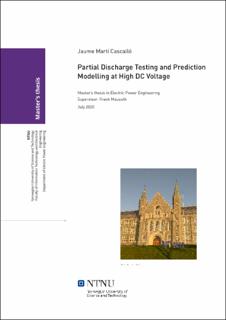| dc.description.abstract | Internal partial discharges can be the cause of irreversible insulation degradation in High Voltage components, which can ultimately cause breakdown. Furthermore, they could become a condition indicator of the components, hinting a possible accelerated ageing due to other degradation mechanisms. Thus, acquiring a better understanding of the Partial Discharge mechanisms is of great interest. AC Partial Discharges have been widely studied, whereas DC Partial Discharges are a lesser-known phenomena.
The main purpose of this thesis is to provide a better understanding of the DC Partial Discharge behaviour. In order to achieve theoretical and practical comprehension, computer modelling and laboratory experiments were carried out during the present thesis. Two High Voltage DC Partial Discharge prediction models were developed and two different cavity sizes were compared for each model. The first model was based on the deterministic theory and the second model was created considering a stochastic starting electron generation rate. Both models were based on the ABC circuit model for internal partial discharges from voids in the insulation.
The laboratory work consisted of improving the sensitivity of an existing Partial Discharge measuring set-up and performing Partial Discharge measurements in polyethylene terephthalate (PET) samples with different size disk-shaped cavities in the centre of the test object employing the improved set-up.
Concordance among the experiments, the High Voltage DC stochastic model and the theory for the time between discharges (tbd) behaviour was found. The time between discharges increases with decreasing cavity diameter due to smaller starting electron generation rate for flat cylindrical cavity geometry. The discharge magnitude was shown to have a similar trend as the time between discharges, thus with a decreasing cavity size the discharge magnitude increased.
The temperature affected the time between discharges, increasing the tbd with decreasing temperature since a temperature reduction decreases the conductivity of the insulating material.
To conclude, a correlation between the cavity size, the time between discharges and the discharge magnitude is present. The relative behaviour can be successfully described by the High Voltage DC stochastic model as well as the stochastic theory and both envisage the observations in the laboratory. However, the correspondence between the stochastic model and the empirical data cannot be conclusively related. | |
